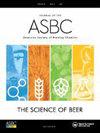Simultaneous Evaluation of β-Glucan and β-Glucanase Relationship during Different Mash Temperature Profiles
IF 1.8
4区 农林科学
Q4 BIOTECHNOLOGY & APPLIED MICROBIOLOGY
Journal of the American Society of Brewing Chemists
Pub Date : 2023-01-12
DOI:10.1080/03610470.2022.2145841
引用次数: 0
Abstract
Abstract High wort β-glucan may contribute to brewery processing problems such as poor run-off, slow filtration, and unwanted haze. To investigate how β-glucanase impacts wort β-glucan throughout mashing, 10 different mashes were considered with varied temperature profiles, malt bills, and levels of malt modification. The European Brewing Congress (EBC) and Institute of Brewing (IoB) mashes were employed to compare the effects of mash conditions on enzyme activity and β-glucan content. Mashes were sampled periodically and evaluated for β-glucan concentration and β-glucanase activity using Megazyme kits adapted to the Gallery™ Plus BeerMaster Discrete Analyzer (Gallery). Enzyme activity quickly decayed in modified IoB mashes (average half-life 12.4 min) accompanied by logarithmic accumulation of wort β-glucan. IoB β-glucan percent extract ranged from 30.3% to 99.5%. In EBC mashes, a slow decay in enzyme activity was followed by an increased rate of decay after 30 min. The β-glucan concentration in well-modified samples remained steady while enzyme activity was appreciable, though it increased after 40 min. As a result, β-glucan percent extract remained relatively low, ranging from 11.9% to 34.3%. The β-glucanase activity at lower temperatures compensates for high malt β-glucan. Measuring wort β-glucan in an EBC mash is insufficient in predicting malt performance in other mash styles. Methods for β-glucan and β-glucanase analysis adapted for the Gallery autoanalyzer increased throughput, enabling analysis of the enzyme and substrate throughout mashing.β-葡聚糖和β-葡聚糖酶关系在不同温度下的同时评价
摘要麦芽汁β-葡聚糖含量高可能会导致啤酒厂的加工问题,如径流差、过滤缓慢和不必要的雾霾。为了研究β-葡聚糖酶如何在整个糖化过程中影响麦芽汁β-葡聚糖,考虑了10种不同的糖化物,它们具有不同的温度、麦芽账单和麦芽改性水平。欧洲酿酒大会(EBC)和酿酒研究所(IoB)采用糖化物来比较糖化物条件对酶活性和β-葡聚糖含量的影响。定期对泥进行取样,并使用适用于Gallery的Megazyme试剂盒评估β-葡聚糖浓度和β-葡聚糖酶活性™ Plus BeerMaster离散分析器(画廊)。改良IoB糖化物中的酶活性迅速衰减(平均半衰期12.4 min),并伴有麦芽汁β-葡聚糖的对数积累。IoBβ-葡聚糖提取物的百分比范围为30.3%至99.5%。在EBC糖化物中,酶活性缓慢衰减,30后衰减率增加 min。经过良好修饰的样品中的β-葡聚糖浓度保持稳定,而酶活性明显,尽管在40后有所增加 min。因此,β-葡聚糖提取物的百分比保持相对较低,在11.9%-34.3%之间。较低温度下的β-葡聚糖酶活性补偿了高麦芽β-葡聚糖。测定EBC麦芽汁中的麦芽汁β-葡聚糖不足以预测其他麦芽汁的麦芽性能。适用于Gallery自动分析仪的β-葡聚糖和β-葡聚糖酶分析方法提高了产量,能够在整个糖化过程中分析酶和底物。
本文章由计算机程序翻译,如有差异,请以英文原文为准。
求助全文
约1分钟内获得全文
求助全文
来源期刊

Journal of the American Society of Brewing Chemists
工程技术-生物工程与应用微生物
CiteScore
4.00
自引率
20.00%
发文量
41
审稿时长
3 months
期刊介绍:
The Journal of the American Society of Brewing Chemists publishes scientific papers, review articles, and technical reports pertaining to the chemistry, microbiology, and technology of brewing and distilling, as well as the analytical techniques used in the malting, brewing, and distilling industries.
 求助内容:
求助内容: 应助结果提醒方式:
应助结果提醒方式:


